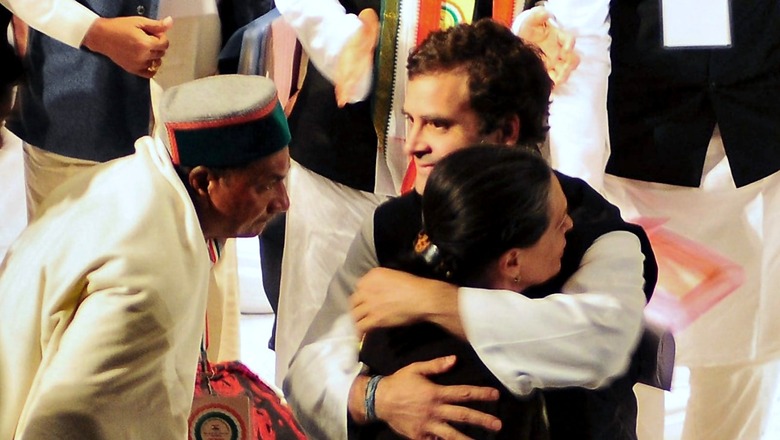
views
Udaipur is paying host to the top brass from the Congress as the grand old party holds its fourth Chintan Shivir since the first one in Pachmarhi, Madhya Pradesh in 1998.
In her inaugural address at the Chintan Shivir on Friday, Sonia Gandhi launched a blistering attack on Prime Minister Narendra Modi’s mantra of ‘minimum government, maximum governance’, alleging that it was keeping the country in a permanent state of polarisation.
Urging party leaders to deliberate with an open mind and send out a clear message of strong organisation and unity, she said the Shivir is also an occasion to deliberate on the many challenges ahead of the party.
“It is both ‘chintan‘ about national issues and meaningful ‘aatmachintan‘ (self-introspection) about our party organisation,” she said.
The 1998 Chintan Shivir was also held during a difficult time for the Congress, but the Udaipur conference is its most challenging yet. With two years to go for 2024 Lok Sabha elections, the Congress is yet to put its house in order. It recently lost power in Punjab, has not yet held organizational elections as demanded by the dissent Group of 23, and may have to reiterate the first-among-equals status of the Gandhi family with an exemption to the ‘one family, one ticket’ rule.
As the party tries to put up a united front in Udaipur, here’s a look at Congress Chintan Shivirs of the past:
Pachmarhi, 1998
The Vichar Manthan Shivir in the hill station was also held months after the Congress dropped to 141 seats in the Lok Sabha in general elections. In her inaugural address, Sonia had expressed concerns over the loss of the party’s social base among voters and, similar to the present, infighting in the ranks.
“Electoral reverses are inevitable and are, in themselves, not cause for worry. But what is disturbing is the loss of our social base… What is also worrisome is that intra-party discord seems to take up so much of our time and energy when it ought to be channelised for working together,” she had said.
Held close to 10 years after India saw its first coalition government at the Centre, Sonia Gandhi surprised observers by virtually ruling out alliances.
“The fact that we are going through a coalition phase at national level politics reflects in many ways the decline of the Congress. This is a passing phase and we will come back again with full force and on our own steam.”
The party declared that “coalitions will be considered only when absolutely necessary and that too on the basis of agreed programmes that will not weaken the party or compromise its basic ideology”.
Adopting a 14-point plan, it called for preference in government employment and promotions for Scheduled Castes (SCs), Scheduled Tribes (STs), Other Backward Classes (OBCs), and minorities. It also made special emphasis on population control, saying, “Any party member who becomes the parent of more than two children after January 1, 2000, will be ineligible for selection or election to any party office or for selection as a party candidate for any election.”
A significant detail amid the current demand for organsational elections in the Congress, the party at the 1998 Shivir, decided to establish a Congress Election Authority to oversee free and fair elections “at all levels of the party”.
Shimla, 2003
The period between Pachmarhi and Shimla was tumultuous for the Congress. The party suffered a worse defeat in the 1999 general elections, plummeting to 114 seats in the Lok Sabha. Senior leaders Sharad Pawar, Tariq Answer and PA Sangma revolted against Sonia Gandhi and walked out of the party.
Learning from Pachmarhi, the party adopted a softer position on coalition politics and called for the unity of secular parties. It called on “progressive thinking men and women, institutions and political movements who share our understanding of India’s past, our concerns with India’s present and our vision of India’s future to join us in this historic endeavour.”
It was at the Shimla Shivir that the party promised to bring in the National Rural Employment Guarantee Act. It also promised nutrition security, social insurance and land reforms.
Jaipur, 2013
The 2013 Chintan Shivir in Jaipur had the stamp of Rahul Gandhi. This was the first Shivir the party was holding while it was in power; it had been for nine years by then. Rahul Gandhi’s “power is poison” remark jostled for headline space along with the fact that he had been elevated as the Congress vice-president.
The party’s public perception, however, was struggling after a slew of scams and a massively popular anti-corruption movement led by Anna Hazare. As the buzz around BJP’s prime ministerial candidate Narendra Modi grew, the Congress declared in Jaipur that it would seek votes on the basis of the Manmohan Singh government’s performance.
“Congress will go to the people on the basis of the performance of the Congress-led UPA government, the promise of stability and good governance, and a restatement of its core values and ideology – secularism, nationalism, social justice, social cohesion, and economic growth for all, especially the ‘aam aadmi’ representing the poor and the middle classes.”
The use of the phrase “aam aadmi” is poignant yet vain in hindsight as it was from the Anna Hazare movement that Arvind Kejriwal rose to form the Aam Aadmi Party which is now positioning itself as the main opposition to the BJP, having edged out the Congress in Delhi and Punjab in a span of 10 years.
Read all the Latest Politics News here

















Comments
0 comment